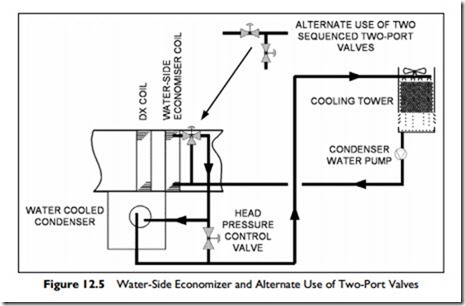Air-Side and Water-Side Economizers
Air-Side Economizers
In the previous chapters, you have been introduced to the air-side economizer on air-handling units. It is the mixing arrangement that allows up to 100% outside air to be drawn in and relieved in order to take advantage of cool outside air, providing “free cooling.” Nothing is free! The air-side economizer equipment costs extra to purchase, there are more components to maintain, and, depending on the climate, the hours when the economizer is actually saving cooling energy may be very limited. In climates that are warm and humid, the number of hours when the outside air has a lower enthalpy than the return air enthalpy may be very few. Thus, Standard 90.1 does not require air-side economizers in most of Florida.
One critical issue with economizers is that their controls must be integrated with the mechanical cooling. This prevents the economizer from increasing the mechanical refrigeration load.
Standard 90.1 has very specific requirements on the control of economizers and, in particular, prohibits the use of mixed air control for economizers on systems that serve more than one zone. Instead, the Standard requires that a supply air thermostat be used to control the cooling coil and economizer. This control method works well as long as the chilled water valve and, if there is one, the heating valve, close fully. If the valves do not close, due to being worn or incorrectly set up, it is possible for the system to use much more energy than expected. Therefore, when this control method is used, it is important that the system be maintained, or that a control sequence is included that will show up the fact that one of the valves is not closing correctly. This control sequence was discussed in section 11.5.
Advantages of the air-side economizer
e A low air pressure drop.
e Substantial mechanical-cooling energy savings.
e Reduced water usage in cooling tower systems.
Disadvantages of the air-side economizer
e Extra capital cost for the 100% intake and relief air equipment, which includes a return fan on larger systems.
e A higher ongoing electrical operating expense.
e A potential requirement for additional humidification during winter operation.
Water-Side Economizers
The water-side economizer consists of a water-cooled coil, located in the air stream just before the mechanical-cooling coil. The coil can be supplied with water directly from the cooling tower or via a plate heat exchanger. If the water is supplied directly from the tower, the water treatment and cleaning process must be of a high standard, to ensure that the valves and coil do not clog up with dirt. If a heat exchanger is used, there is the additional cost of the exchanger, and the heat transfer will be less efficient, since there has to be a temperature rise across the exchanger for it to work.
There are several possible arrangements, depending on the particular equipment and sizes. One example for packaged units is shown in Figure 12.5. The three-port valve determines how much of the tower water flows through the economizer coil, and the two-port valve determines how much water bypasses the condenser to avoid the condenser being overcooled.
Note that the three-port valve can be replaced with two two-port valves, as shown in the detail. The valves would be sequenced so that, as one opens, the other closes, to provide the same effect as the mixing valve, but often at lower cost in small sizes.
The “head pressure” is the pressure in the refrigeration condenser. If the head pressure falls below the required pressure, the valve is opened to reduce water flow through the condenser. On cool days, when the tower produces very cold water, the valve will stay open, since adequate cooling is provided at well below full design flow.
Advantages of water-side economizers
e Water-side economizers reduce compressor energy requirements by pre- cooling the air.
e Unlike air-side economizers, which need full sized intake and relief ducts for 100% outside air entry or for 100% exhaust, water-side economizers simply require space for two pipes.
e Unlike the air-side economizer, the water-side economizer does not lower the humidity in winter, saving on possible humidification costs.
Disadvantages of a water-side economizer
e Higher resistance to airflow, therefore higher fan energy costs. e Increased tower operation with consequent reduction in life. e Increased water and chemicals cost.
